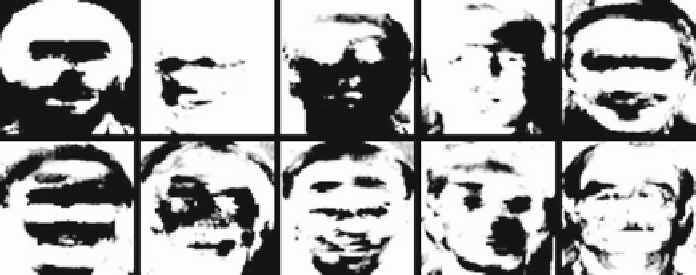Information Technology Reference
In-Depth Information
0 and 255. As an example, few sample images are shown in Fig.
7.1
. A total of 160
images (four of each subject) have been used for training and rest 240 for testing.
Feature vector for each image has been created based on 48 dominant principal
components, which are used into classification or recognition. The squared error or
absolute error from each output is used to decide the identity claim in a subject. The
claim is accepted if error is less than threshold.
Eigenvectors with higher eigenvalues provide more information on the face varia-
tion than those with smaller eigenvalues. The eigenvectors (eigenfaces) correspond-
ing to largest eigenvalues, derived from the ORL face database, are shown in Fig.
7.2
.
Similarly, the eigenvectors corresponding to the smallest eigenvalues are shown in
Fig.
7.3
. The eigenvectors are ordered according to decreasing eigenvalues in each
figure. Each individual face in the face set can then be approximated by a linear combi-
nation of the eigenvectors associated with largest eigenvalues. Similarly, independent
components obtained by ICA algorithm are used as feature vectors for classification.
ICA separates the high-order moments of the input in addition to the second-order
moments utilized in PCA [
31
,
38
]. The basis vectors obtained by Infomax algorithm
for ICA representation are shown in Fig.
7.4
.
Eigenvalues in
R
PCA
and
C
PCA
can be used to plot a graph (Fig.
7.5
) of variance
captured by each principal component. It is essentially the cumulative distribution
for
M
components and defined in Eq. (
7.21
). This graph allows us to select the
dominant eigenvectors for feature extraction. It is found that 48 eigenvectors or
30% of maximum possible number of eigenvalues (training set has 160 images)
of
C
PCA are enough to account for more than 93% of the variations among the
training set. While, approximately 85% of total variance is retained in same number
Fig. 7.1
Some example images from the ORL face database
Fig. 7.2
Eigenvectors corresponding to the largest eigenvalues, derived from the ORL face database




Search WWH ::

Custom Search